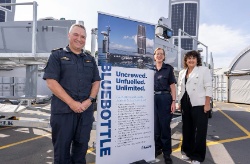High-resolution Mapping Of Otago’s Entire Coastline Completed - ORC
A new high-resolution ground mapping dataset of Otago’s entire coastline is complete – now including about 30-40 kilometres inland - covering a total 4250 square kilometres of land.
The high-resolution 3D ground elevation data for the coastline and its catchments is now available online via the LINZ Data Service and Open Topo web sites, says Otago Regional Council’s Spatial Analyst, Andrew Welsh.
“The geospatial dataset will be an invaluable tool in identifying, mapping and managing natural hazards, be it flooding, erosion or landslips,” he says.
A further almost 4000 square kilometres of data from around Central Otago is expected to be released later this year.
The 3D mapping data has just been publicly released as part of the Provincial Growth Fund-LiDAR elevation data capture project.
Co-funding from the Provincial Growth Fund is supporting the substantial regional expansion of the New Zealand
National Elevation Programme - which is based on partnerships between councils and Toitū Te Whenua Land Information New Zealand (LINZ).
“In terms of studying natural hazards, the LiDAR mapping is a critical dataset to investigate and assess the characteristics of natural hazards,” Mr Welsh says.

Mr Welsh says the previous coastal LiDAR work took elevation measurements at about 2 points per square metre, but the new dataset is at 4 points per square metre.
“This allows for a more detailed look at the shape and characteristics of the ground surface in Otago’s Coastal Catchments,” he says.
The new data set will give a “significant improvement” on coverage for Otago’s coastline and associated catchments,
as the last data capture in 2004 only extended about 1.5 kilometres inland from the coastline, he says. “This new capture extends a lot further inland to provide much greater coverage of Otago’s coastal catchments,” he says.
The same ground mapping dataset for Dunedin and Mosgiel’s urban areas was made publicly available last year.
To complete the project in Otago, data on the Manuherikia Catchment has been captured and is being processed at present, which includes surrounding areas in Central Otago.
The Manuherikia catchment and Central Otago covers about 3950 square km and is expected to be completed and made publicly available later this year.
“This gives a give a high-resolution data set, essentially a ‘lens’ on the elevation of the land surfaces,” Mr Welsh says.

Toitu Te Whenua LINZ Location Data Analyst Abbey Douglas was asked how LiDAR can assist with floods; as has been seen recently across the North Island.
“LiDAR provides accurate, high-resolution elevation of the ground surface which is essential for reliable river and stormwater flood modelling. Such models are critical for planning and developing infrastructure which is resilient to flood events,” she says.
The LINZ Data Service
LINZ Senior Technical Leader Elevation and Imagery Bjorn Johns says ORC is one council of 10 regions
partnering with Toitū Te Whenua LINZ to obtain a baseline elevation data set, which is freely available
on the LINZ Data Service.
LiDAR now covers about 40% of New Zealand and the national coverage is scheduled to grow to 80%
coverage in 2024, when the Provincial Growth Fund-LiDAR project is completed.
Mr Welsh says the data which LiDAR generates is invaluable in understanding and preparing for natural
hazards, plus informing around infrastructure management, hydrology, catchment planning, and in
many other applications.
“The LiDAR data and its derivatives such as digital elevation and digital surface models, can be used in
many natural hazard applications, such natural hazard mapping, change detection analysis and hydrological modelling.”
“This will enhance our understanding of earth surface processes and potentially help to inform risk mapping
and planning decisions,” he says.
Many groups can benefit from using the data set, including ecologists for wetland mapping or for engineers
to inform flood protection planning and many research institutions.
How the aerial data capture works
In low level, fixed-wing flyovers firing light pulses to the ground and in measuring the return echo, the point
measurements of the ground surface’s elevation measurements are recorded.
The pulse allows for discrimination between different surface types and ground features, such as trees and
buildings against the bare earth ground surface.
Links to the LiDAR dataset
- DEM
- DSM
- Tile index
- Point cloud
Links for examples of LiDAR
- More about the Toitū Te Whenua LINZ LiDAR elevation data programme
- See topographic data from throughout New Zealand on the LINZ Data Service


 Gordon Campbell: On The Left’s Electability Crisis, And The Abundance Ecotopia
Gordon Campbell: On The Left’s Electability Crisis, And The Abundance Ecotopia NZCAST: NZCAST Leads Ongoing Cross-Agency Collaboration To Break Down Barriers For Survivors Of State Abuse
NZCAST: NZCAST Leads Ongoing Cross-Agency Collaboration To Break Down Barriers For Survivors Of State Abuse Regional and Unitary Councils Aotearoa: Regional And Unitary Councils Back A Practical FWFP System
Regional and Unitary Councils Aotearoa: Regional And Unitary Councils Back A Practical FWFP System NZ Government: Stay Safe On Our Roads This Easter
NZ Government: Stay Safe On Our Roads This Easter YWCA: Global Push Back Against Gender Equality A Growing Crisis In Aotearoa
YWCA: Global Push Back Against Gender Equality A Growing Crisis In Aotearoa Te Pāti Māori: Ngarewa-Packer - Fast-Tracking Seabed Mining Ignores Māori Opposition And Environmental Precedent
Te Pāti Māori: Ngarewa-Packer - Fast-Tracking Seabed Mining Ignores Māori Opposition And Environmental Precedent New Zealand Defence Force: Defence And Customs Strengthen Maritime Security With Uncrewed Surface Vessels
New Zealand Defence Force: Defence And Customs Strengthen Maritime Security With Uncrewed Surface Vessels


